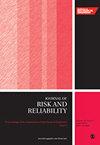一种新的单失效模式和双失效模式系统的失效次数模型:基于哈密顿蒙特卡罗模拟的贝叶斯研究
IF 1.8
4区 工程技术
Q3 ENGINEERING, INDUSTRIAL
Proceedings of the Institution of Mechanical Engineers Part O-Journal of Risk and Reliability
Pub Date : 2023-01-20
DOI:10.1177/1748006x221146367
引用次数: 3
摘要
本文介绍了一种四参数混合概率分布——加性Gompertz-Weibull分布及其在可靠性工程中的应用。所提出的模型的故障率(FR)函数显示出增加的趋势和各种浴缸形状,有或没有低但长期稳定的部分,使其适合于建模各种现实世界的问题。研究了AGW的FR与其平均剩余寿命函数之间的关系。对于参数估计,考虑了极大似然和贝叶斯推理。对于后验模拟,我们使用哈密顿蒙特卡罗来评估AGW参数的贝叶斯估计。我们在三个故障时间数据集上评估了所提出的AGW模型的性能,并与采用相同方法构建的其他近期浴缸分布的性能进行了比较。前两个数据集代表设备故障次数,而第三个数据集代表早期电缆接头故障次数,所有数据集都具有浴缸FR。为了进行比较,使用了五个参数和非参数评估标准以及拟合的FR和平均剩余寿命曲线。结果表明,AGW模型将是描述故障时间的最佳选择,特别是当所提供数据集的浴缸形FR显示其三个部分时。本文章由计算机程序翻译,如有差异,请以英文原文为准。
A new failure times model for one and two failure modes system: A Bayesian study with Hamiltonian Monte Carlo simulation
This paper presents an additive Gompertz-Weibull (AGW) distribution, a four-parameter hybrid probability distribution, and its applications in reliability engineering. The failure rate (FR) function of the proposed model demonstrates an increasing trend and a variety of bathtub shapes with or without a low and yet long-stable segment, making it appropriate for modelling a wide variety of real-world problems. Some relationships between the AGW’s FR and its mean residual life functions are examined. For parameter estimation, maximum likelihood and Bayesian inferences are considered. For posterior simulations, we use Hamiltonian Monte Carlo to evaluate the Bayes estimators of the AGW parameters. We evaluate the performance of the proposed AGW model to that of other recent bathtub distributions constructed following the same approach on three failure time datasets. The first two datasets represent device failure times, while the third represents early cable-joint failure times, all with bathtub FR. For comparison, five parametric and nonparametric evaluation criteria and the fitted FR and mean residual life curves were employed. The results indicated that the AGW model would be the best choice for describing failure times, especially when the bathtub-shaped FR of the presented dataset exhibits its three segments.
求助全文
通过发布文献求助,成功后即可免费获取论文全文。
去求助
来源期刊

Proceedings of the Institution of Mechanical Engineers Part O-Journal of Risk and Reliability
ENGINEERING, MULTIDISCIPLINARY-ENGINEERING, INDUSTRIAL
CiteScore
4.50
自引率
19.00%
发文量
81
审稿时长
6-12 weeks
期刊介绍:
The Journal of Risk and Reliability is for researchers and practitioners who are involved in the field of risk analysis and reliability engineering. The remit of the Journal covers concepts, theories, principles, approaches, methods and models for the proper understanding, assessment, characterisation and management of the risk and reliability of engineering systems. The journal welcomes papers which are based on mathematical and probabilistic analysis, simulation and/or optimisation, as well as works highlighting conceptual and managerial issues. Papers that provide perspectives on current practices and methods, and how to improve these, are also welcome
 求助内容:
求助内容: 应助结果提醒方式:
应助结果提醒方式:


